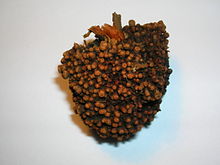Frankia
| Frankia | |
|---|---|

| |
| An alder root nodule. | |
| Scientific classification | |
| Domain: | Bacteria |
| Phylum: | Actinomycetota |
| Class: | Actinomycetia |
| Order: | Frankiales |
| Family: | Frankiaceae Becking 1970 (Approved Lists 1980)[2] |
| Genus: | Frankia Brunchorst 1886[1] |
| Type species | |
| Frankia alni (Woronin 1866) Von Tubeuf 1895 non Steud. 1840
| |
| Species[3] | |
|
See text | |
| Synonyms | |
Frankia is a genus of nitrogen-fixing bacteria that live in symbiosis with actinorhizal plants, similar to the Rhizobium bacteria found in the root nodules of legumes in the family Fabaceae. Frankia also initiate the forming of root nodules.
This genus was originally named by

Overview
Most Frankia strains are specific to different plant species. The bacteria are filamentous and convert atmospheric nitrogen into ammonia via the enzyme nitrogenase, a process known as nitrogen fixation. They do this while living in root nodules on actinorhizal plants. The bacteria can supply most or all of the nitrogen requirements of the host plant. As a result, actinorhizal plants colonise and often thrive in soils that are low in plant nutrients.[6]
Several Frankia genomes are now available which may help clarify how the symbiosis between prokaryote and plant evolved, how the environmental and geographical adaptations occurred, the metabolic diversity, and the horizontal gene flow among the symbiotic prokaryotes.[6]
Frankia can resist low concentration of heavy metals such as, Cu, Co, and Zn.[7] Frankia may be an advantage for degraded soil. Degraded soil is known as soil that is heavy metal rich or nutrient depleted due to a drought. Frankia is a nitrogen-fixed organism, explaining why it is able to resist heavy metals.[8][clarification needed]
Frankia is a gram-positive Bacteria that is found on the roots of plants. The fact that Frankia is gram-positive means that the bacteria is made up of thick cell walls made out of protein called peptidologlycan. This helps with the resistance of the heavy metals that may be in the degraded soil.[9]
Frankia tolerates a narrow range of temperatures and soil pH levels. It grows best at around 30 degrees Celsius with an environment pH between 6.5 and 7.[10] These facts shows that Frankia is very sensitive to its environment. Though Frankia would not be suitable for all agriculture it does demonstrate possibilities in select areas, or in temperature controlled environments.[citation needed]
Symbiont plants
- All species in the genus Alnus in the family Betulaceae
- Some species in all four genera in the family Casuarinaceae
- Certain species in the genus Coriariaceae
- Datiscaceae
- All species in the three genera in the family Elaeagnaceae, Elaeagnus, Shepherdia, and Hippophae
- All species in the genera Morella, and Comptonia in the family Myricaceae.
- All species in six genera in the family Rhamnaceae, Ceanothus, Colletia, Discaria, Trevoa, and possibly Adolphia
- Some species in the family
Phylogeny
The currently accepted taxonomy is based on the List of Prokaryotic names with Standing in Nomenclature (LPSN)[3] and National Center for Biotechnology Information (NCBI)[12]
| 16S rRNA based | 120 marker proteins based GTDB 08-RS214[16][17][18] | ||||||||||||||||||||||||||||||||||||||||||||||||||||||||||||||||||||||||||||||||||||||||||||||||||||||||||||||||||||||||||||||||||||||||||||||||
|---|---|---|---|---|---|---|---|---|---|---|---|---|---|---|---|---|---|---|---|---|---|---|---|---|---|---|---|---|---|---|---|---|---|---|---|---|---|---|---|---|---|---|---|---|---|---|---|---|---|---|---|---|---|---|---|---|---|---|---|---|---|---|---|---|---|---|---|---|---|---|---|---|---|---|---|---|---|---|---|---|---|---|---|---|---|---|---|---|---|---|---|---|---|---|---|---|---|---|---|---|---|---|---|---|---|---|---|---|---|---|---|---|---|---|---|---|---|---|---|---|---|---|---|---|---|---|---|---|---|---|---|---|---|---|---|---|---|---|---|---|---|---|---|---|---|
|
|
Species incertae sedis:
- F. nepalensis Nouioui et al. 2023
See also
References
- ^ Brunchorst J. (1886). "Über einige Wurzelanschwellungen, besonders diejenigen von Alnus und den Elaegnaceen" [On root swellings, particularly those of Alnus and the Elaeagnaceae]. Untersuchungen aus dem botanischen Institut in Tübingen [Investigations of the Botanical Institute in Tübingen ]. 2 (151–177).
- .
- ^ a b A.C. Parte; et al. "Frankia". List of Prokaryotic names with Standing in Nomenclature (LPSN). Retrieved 2023-09-09.
- ISBN 9783540754602.
- ^ "Frankia taxonomy". Archived from the original on 2011-07-27. Retrieved 2011-01-14.
- ^ a b Frankia and Actinorhizal Plants
- S2CID 49639716.
- S2CID 49639716.
- S2CID 39458226.
- S2CID 38519293.
- ISBN 978-0126332100.
- ^ Sayers; et al. "Frankia". National Center for Biotechnology Information (NCBI) taxonomy database. Retrieved 2023-09-09.
- ^ "The LTP". Retrieved 20 November 2023.
- ^ "LTP_all tree in newick format". Retrieved 20 November 2023.
- ^ "LTP_08_2023 Release Notes" (PDF). Retrieved 20 November 2023.
- ^ "GTDB release 08-RS214". Genome Taxonomy Database. Retrieved 10 May 2023.
- ^ "bac120_r214.sp_label". Genome Taxonomy Database. Retrieved 10 May 2023.
- ^ "Taxon History". Genome Taxonomy Database. Retrieved 10 May 2023.
- PMID 30059001.
- S2CID 41316476.
